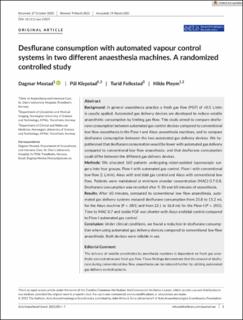| dc.contributor.author | Mostad, Dagmar | |
| dc.contributor.author | Klepstad, Pål | |
| dc.contributor.author | Follestad, Turid | |
| dc.contributor.author | Pleym, Hilde | |
| dc.date.accessioned | 2021-10-27T07:21:50Z | |
| dc.date.available | 2021-10-27T07:21:50Z | |
| dc.date.created | 2021-06-21T19:29:41Z | |
| dc.date.issued | 2021 | |
| dc.identifier.citation | Acta Anaesthesiologica Scandinavica. 2021, 1-7. | en_US |
| dc.identifier.issn | 0001-5172 | |
| dc.identifier.uri | https://hdl.handle.net/11250/2825857 | |
| dc.description.abstract | Background: In general anaesthesia practice a fresh gas flow (FGF) of ≥0.5 L/min is usually applied. Automated gas delivery devices are developed to reduce volatile anaesthetic consumption by limiting gas flow. This study aimed to compare desflurane consumption between automated gas control devices compared to conventional low flow anaesthesia in the Flow-I and Aisys anaesthesia machines, and to compare desflurane consumption between the two automated gas delivery devices. We hypothesised that desflurane consumption would be lower with automated gas delivery compared to conventional low flow anaesthesia, and that desflurane consumption could differ between the different gas delivery devices. Methods: We allocated 160 patients undergoing robot-assisted laparoscopic surgery into four groups, Flow-I with automated gas control, Flow-i with conventional low-flow (1 L/min), Aisys with end tidal gas control and Aisys with conventional low flow. Patients were maintained at minimum alveolar concentration (MAC) 0.7-0.8. Desflurane consumption was recorded after 9, 30 and 60 minutes of anaesthesia. Results: After 60 minutes, compared to conventional low flow anaesthesia, automated gas delivery systems reduced desflurane consumption from 25.8 to 15.2 mL for the Aisys machine (P < .001) and from 22.1 to 16.8 mL for the Flow-I (P < .001). Time to MAC 0.7 and stable FGF was shorter with Aisys endtidal control compared to Flow-I automated gas control. Conclusion: Under clinical conditions, we found a reduction in desflurane consumption when using automated gas delivery devices compared to conventional low flow anaesthesia. Both devices were reliable in use. | en_US |
| dc.language.iso | eng | en_US |
| dc.publisher | Wiley | en_US |
| dc.rights | Attribution-NonCommercial-NoDerivatives 4.0 Internasjonal | * |
| dc.rights.uri | http://creativecommons.org/licenses/by-nc-nd/4.0/deed.no | * |
| dc.title | Desflurane consumption with automated vapour control systems in two different anaesthesia machines. A randomized controlled study | en_US |
| dc.type | Peer reviewed | en_US |
| dc.type | Journal article | en_US |
| dc.description.version | publishedVersion | en_US |
| dc.source.pagenumber | 1-7 | en_US |
| dc.source.journal | Acta Anaesthesiologica Scandinavica | en_US |
| dc.identifier.doi | 10.1111/aas.13825 | |
| dc.identifier.cristin | 1917515 | |
| cristin.ispublished | true | |
| cristin.fulltext | original | |
| cristin.qualitycode | 1 | |

